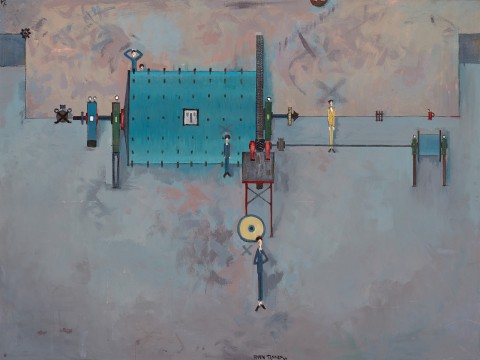THE ENGINEER'S WORKSHOP, 1957
EDWIN TANNER
oil on canvas on composition board
89.0 x 120.0 cm
signed lower centre: EDWIN TANNER
dated upper left: 57.
possibly: Rudy Komon, Sydney
Ray Hughes, Sydney
Estate of Ray Hughes, Sydney
Edwin Tanner: Works 1952– 1980, Monash University Gallery, Melbourne, 15 March – 12 May 1990, cat. 20
Edwin Tanner: Paintings 1952 – 1979, The Hughes Gallery, Sydney, 30 October – 25 November 2014, cat. 24; Charles Nodrum Gallery, Melbourne, 12 March – 4 April 2015, cat. 7
Duncan, J., Edwin Tanner Works 1952–1980, Monash University Gallery, Melbourne, 1990, pp. 18 (illus.) 26
Hemingway, B., and Nodrum, C., Edwin Tanner: Paintings 1952 – 1979, The Estate of Edwin Tanner in association with The Hughes Gallery, Sydney & Charles Nodrum Gallery, Melbourne, 2014, pp. 28 – 29 (illus.)
The Engineers’ Workshop II, 1957, oil on canvas on composition board, 90.1 x 123.5 cm, in the collection of the TarraWarra Museum of Art, Victoria
Edwin Tanner is perhaps one of Australia’s most idiosyncratic artists. A polymath whose unusual and diverse career progression and broad range of intellectual pursuits informed his paintings, Tanner produced works that stood well apart from the regional gestural expressionism practiced around the country during the second half of the twentieth century. Having emigrated from Wales in the early 1920s, the Tanner family worked as miners in the region around Newcastle, while young Edwin showed early aptitude for mathematics and mechanical engineering. Between 1935 and 1954, while the burgeoning artist first started showing his works at the Contemporary Arts Society in Sydney, Tanner steadily and tirelessly accumulated apprenticeships and degrees by correspondence in engineering, civil design, physics, logic, mathematics and philosophy. These accolades earned him a promotion as Chief Engineer at the construction company, S. Haunstrup & Co. Pty Ltd, in Melbourne, then at Australian Steel and Concrete the following year and eventually, the establishment of Tanner’s own engineering consultancy in 1960.
This iconic and autobiographical painting, The Engineer's Workshop, 1957, was painted in the middle of these years of professional successes, on the cusp of Tanner’s artistic élan. Firmly based in a figurative reiteration of his real-world experience, The Engineer's Workshop is populated by spindly figures standing stiffly in their place of work, dwarfed by a central machine, whose rectilinear forms recall electric circuitry and remain obscure to even the most scientifically literate of viewers. With a poetic sensibility for negative space and colour, Tanner’s work here is subtle and quietly humorous. While the machine and the architectural space in which these figures stand are harshly delineated with vertical and horizonal lines, the floors and walls are painted with broad and expressive brushstrokes, creating unexpected tension within the composition. In this workshop, Tanner’s figures are marooned in a vast expanse of emptiness, standing beside an enormous machine, amongst broad brushstrokes and delicately changing hues, expectant and confused.
Tanner was presciently attuned to the interdependence of man and machine, and conveyed these notions in his paintings, often endowing machines with anthropomorphic features. When introducing figures into his compositions, these were often static, if not completely reduced to geometric shapes, as can be seen in Board of Directors, 1956. An abstract work, this painting depicted public servants as little more than conductive tracks and nodes on a circuit board, making a pun on the limited individual power and the conformity that is imposed on such workers. Tanner’s works are often characterised by a flatness and strict adherence to the straight line and its associated grid format. However, his interest in philosophy, poetry and music endowed his paintings with a lyrical, if cryptic, sensibility. His paintings are often deadpan and laconic, presenting social critiques under a thin veil of metaphor.
For all of Tanner’s eccentricities, he produced an astounding body of work, using a vocabulary and syntax that was purely his own. His stark matrices of straight lines divide sparse expanses of paint, transforming the painting plane into a design blueprint whose secrets are clear only to the artist. Although at times his tongue-in-cheek social commentary inflamed public opinion, during his lifetime Tanner largely remained neglected by the press and the art establishment, his works prized among artists and a small group of connoisseurs appreciative of the inventiveness of his unique artistic vision. Today his place has been rightfully re-established and solidified through further acquisitions by the National Gallery of Victoria, the Queensland Gallery of Modern Art, the Art Gallery of New South Wales, and most recently, a major retrospective exhibition held at TarraWarra Museum of Art.
LUCIE REEVES-SMITH
